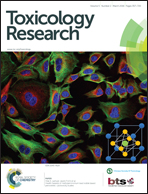Physicochemical insights of irradiation-enhanced hydroxyl radical generation from ZnO nanoparticles†
Abstract
The widespread use of zinc oxide nanoparticles (ZnO NPs) has raised environmental and human health concerns owing to their significant cytotoxicity. Although their cytotoxic effects have been associated with reactive oxygen species (ROS), the physicochemical mechanism underlying this phenomenon remains poorly understood. In this study, the physicochemical properties of ZnO NPs were systematically investigated in relation to their effect on ROS generation. Factors that were found to affect hydroxyl radical (˙OH) generation included: NP concentration, irradiation, NP hydrodynamic size, localized pH, ionic strength, NP zeta-potential, and dissolved oxygen levels. The mechanism by which ˙OH was generated under alkaline conditions was found to obey first-order reaction kinetics that followed the conversion of OH− anions and dissolved O2 to ˙OH. Based on these findings, we propose that ZnO NP cytotoxicity involves ˙OH adsorption to the nanoparticle surface, creating a highly localized source of ROS capable of potentiating oxidative damage to cellular structures. This hypothesis was evaluated with time-resolved intracellular calcium [Ca]i imaging that irradiated ZnO NPs triggered cytoplasmic calcium influxes and facilitated nuclear degradation. Together these findings present a novel physicochemical mechanism for ˙OH generation from ZnO NPs with significant implications for nanoparticle cytotoxicity and their relation to human health.


 Please wait while we load your content...
Please wait while we load your content...